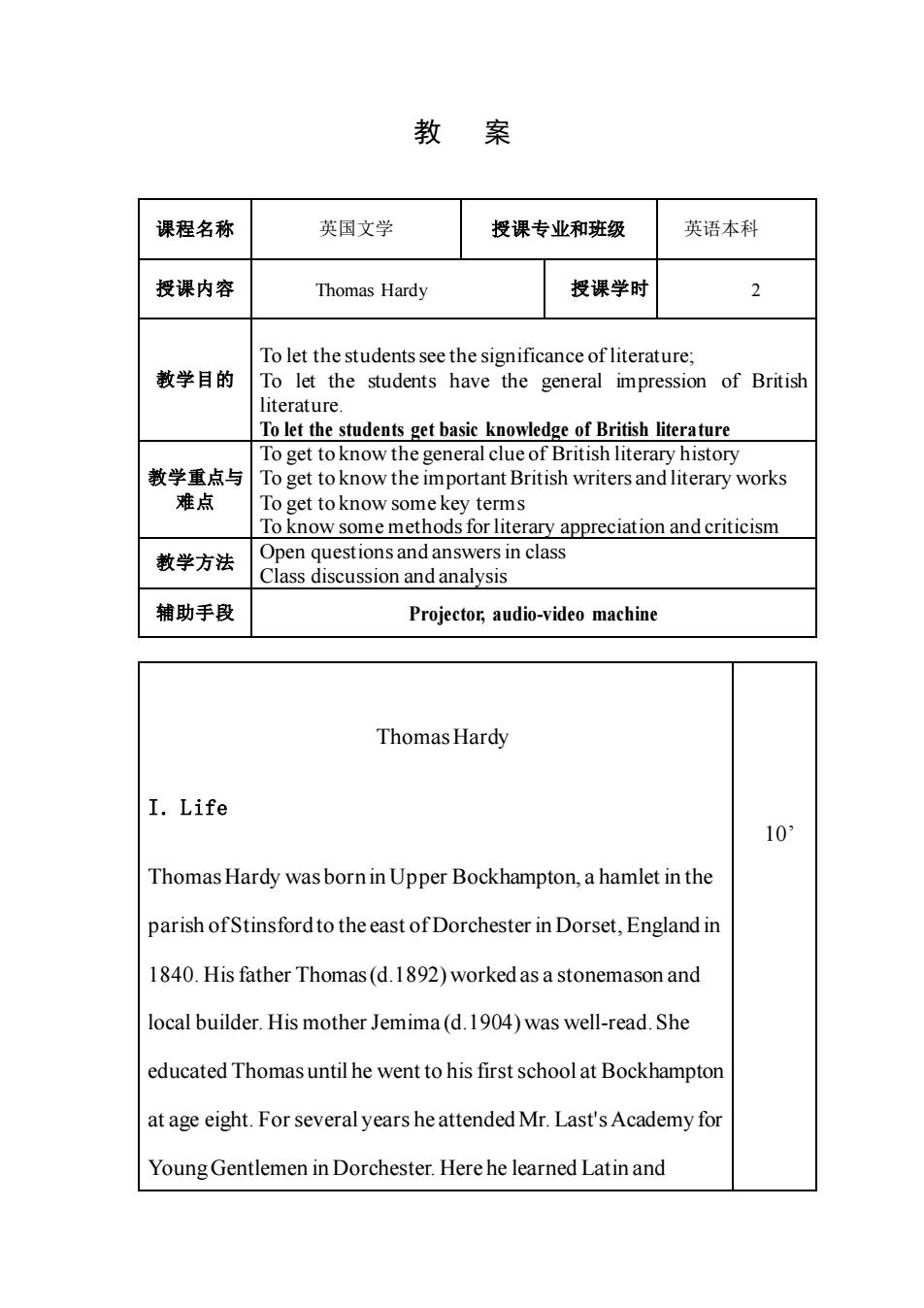
教案 课程名称 英国文学 授课专业和班级 英语本科 授课内容 Thomas Hardy 授课学时 To let the students see the significance of literature; 教学目的 To let the students have the general impression of British terature To let the students get basic knowledge of British literature To get to know the general clue of British literary history 教学重点与To get to know the important British writers and literary works 难点 To get toknow some key terms Toknowsome methods for literary 教学方法 Open questions and answers in class Class discussion and analysis 辅助手段 Projector,audio-video machine Thomas Hardy I.Life 10 Thomas Hardy was born in Upper Bockhampton,a hamlet in the parish ofStinsfordto the east of Dorchester in Dorset,England in 1840.His father Thomas(d.1892)worked as a stonemason and local builder.His mother Jemima(d.1904)was well-read.She educated Thomas until he went to his first school at Bockhampton at age eight.For several years he attended Mr.Last's Academy for Young Gentlemen in Dorchester.Here he learned Latin and
教 案 课程名称 英国文学 授课专业和班级 英语本科 授课内容 Thomas Hardy 授课学时 2 教学目的 To let the students see the significance of literature; To let the students have the general impression of British literature. To let the students get basic knowledge of British literature 教学重点与 难点 To get to know the general clue of British literary history To get to know the important British writers and literary works To get to know some key terms To know some methods for literary appreciation and criticism 教学方法 Open questions and answers in class Class discussion and analysis 辅助手段 Projector, audio-video machine Thomas Hardy I. Life Thomas Hardy was born in Upper Bockhampton, a hamlet in the parish of Stinsford to the east of Dorchesterin Dorset, England in 1840. His father Thomas (d.1892) worked as a stonemason and local builder. His mother Jemima (d.1904) was well-read. She educated Thomas until he went to his first school at Bockhampton at age eight. For several years he attended Mr. Last's Academy for Young Gentlemen in Dorchester. Here he learned Latin and 10’

demonstrated academic potential.[1]However,a family of Hardy's social position lacked the means for a university education,and his formal educationended at the age of sixteen when he became apprenticed to James Hicks,a localarchitect.[2] Hardy trained as an architect in Dorchester before moving to London in 1862;there heenrolled as a student at King's College, London.He won prizes from the Royal Institute ofBritish Architects and the Architectural Association.Hardy never felt at home in London.He was acutely conscious ofclass divisions and his social inferiority.However,he was interested in socialreform and was familiar with the works of John Stuart Mill.He was also introduced to the worksofCharles Fourier and Auguste Comte duringthis period by his Dorset friend,Horace Moule.Fiveyears later,concerned about his health,hereturned to Dorset and decided to dedicate himselfto writing. In 1870,while on an architectural mission to restore the parish church of St Juliot in Cornwall,[3]Hardy met and fell in love 10 with Emma Lavinia Gifford,whom he married in 1874.[4][5] Although he later becameestranged from his son her death in 1912 had a traumatic effect on him.After her death,Hardy made a trip to Cornwall to revisit places linked with their courtship,and
demonstrated academic potential.[1]However, a family of Hardy's social position lacked the means for a university education, and his formal education ended at the age of sixteen when he became apprenticed to James Hicks, a local architect.[2] Hardy trained as an architect in Dorchester before moving to London in 1862; there he enrolled as a student at King's College, London. He won prizes from the Royal Institute of British Architects and the Architectural Association. Hardy never felt at home in London. He was acutely conscious of class divisions and his social inferiority. However, he was interested in social reform and was familiar with the works of John Stuart Mill. He was also introduced to the works of Charles Fourier and Auguste Comte during this period by his Dorset friend, Horace Moule. Five years later, concerned about his health, he returned to Dorset and decided to dedicate himself to writing. In 1870, while on an architectural mission to restore the parish church of St Juliot in Cornwall,[3]Hardy met and fell in love with Emma Lavinia Gifford, whom he married in 1874.[4][5] Although he later became estranged from his son her death in 1912 had a traumatic effect on him. After her death, Hardy made a trip to Cornwall to revisit places linked with their courtship, and 10’

his Poems 1912-13reflect upon her death.In 1914,Hardy married his secretary Florence Emily Dugdale,who was 39 years his junior.However,he remained preoccupied with his first wife's death and tried to overcome his remorse by writingpoetry.[6] Hardy became ill with pleurisy in December 1927and died at Max Gate just after 9 pm on 11 January 1928,having dictated his final poem to his wife on his deathbed;the cause ofdeath was cited,on his death certificate,as"cardiacsyncope",with"old age"given as a contributory factor.His funeral was on 16 January at Westminster Abbey,and it proved a controversial occasion because Hardy and his family and friends had wished for his body to be interred at Stinsford in the same graveas his first wife Emma.However,his executor,Sir Sydney Carlyle Cockerell, insisted that he be placed in theabbey's famous Poets'Corner.A compromise was reached whereby his heart was buried at Stinsford with Emma,and his ashes in Poets'Corner. Shortly after Hardy'sdeath,theexecutorsofhis estate burnt his letters and notebooks.Twelve records survived,one ofthem 10 containing notes and extracts ofnewspaper stories from the 1820s.Research into these provided insight into how Hardy kept track ofthem and how he used them in his later work.[7]In the
his Poems 1912–13 reflect upon her death. In 1914, Hardy married his secretary Florence Emily Dugdale, who was 39 years his junior. However, he remained preoccupied with his first wife's death and tried to overcome his remorse by writing poetry.[6] Hardy became ill with pleurisy in December 1927 and died at Max Gate just after 9 pm on 11 January 1928, having dictated his final poem to his wife on his deathbed; the cause of death was cited, on his death certificate, as "cardiac syncope", with "old age" given as a contributory factor. His funeral was on 16 January at Westminster Abbey, and it proved a controversial occasion because Hardy and his family and friends had wished for his body to be interred at Stinsford in the same grave as his first wife, Emma. However, his executor, Sir Sydney Carlyle Cockerell, insisted that he be placed in the abbey's famous Poets' Corner. A compromise was reached whereby his heart was buried at Stinsford with Emma, and his ashes in Poets' Corner. Shortly after Hardy's death, the executors of his estate burnt his letters and notebooks. Twelve records survived, one of them containing notes and extracts of newspaper stories from the 1820s. Research into these provided insight into how Hardy kept track of them and how he used them in his later work.[7]In the 10’

year ofhis death Mrs Hardy published The Early Life of Thomas Hardy,1841-1891:compiled largely from contemporary notes, letters,diaries,and biographical memoranda,as well as from oral information in conversations extendingover many years Hardy's work was admired by many writers ofa younger generation including D.H.Lawrence and Virginia Woolf.In his autobiography Goodbye to All That,Robert Graves recalls meeting Hardy in Dorset in the early 1920s.Hardy received him and his new wife warmly,and was encouraging about his work. In 1910,Hardy wasawarded the Order ofMerit. Hardy's cottage at Bockhampton and Max Gate in Dorchester are owned by the National Trust. II.Points of View: 10 Hardy is much influenced by scientific discoveries and philosophers of the new school.He read Darwin's Origin of Species and accepted his theory of "survival of the fittest."His reading of Spencer's First Principle inspired his pessimistic determinism and led him to the belief that man's fate was predeterminedly tragic. In his works,man is shown driven by a combined force of
year of his death Mrs Hardy published The Early Life of Thomas Hardy, 1841–1891: compiled largely from contemporary notes, letters, diaries, and biographical memoranda, as well as from oral information in conversations extending over many years. Hardy's work was admired by many writers of a younger generation including D. H. Lawrence and Virginia Woolf. In his autobiography Goodbye to All That, Robert Graves recalls meeting Hardy in Dorset in the early 1920s. Hardy received him and his new wife warmly, and was encouraging about his work. In 1910, Hardy was awarded the Order of Merit. Hardy's cottage at Bockhampton and Max Gate in Dorchester are owned by the National Trust. II. Points of View: Hardy is much influenced by scientific discoveries and philosophers of the new school. He read Darwin’s Origin of Species and accepted his theory of “survival of the fittest.” His reading of Spencer’s First Principle inspired his pessimistic determinism and led him to the belief that man’s fate was predeterminedly tragic. In his works, man is shown driven by a combined force of 10’
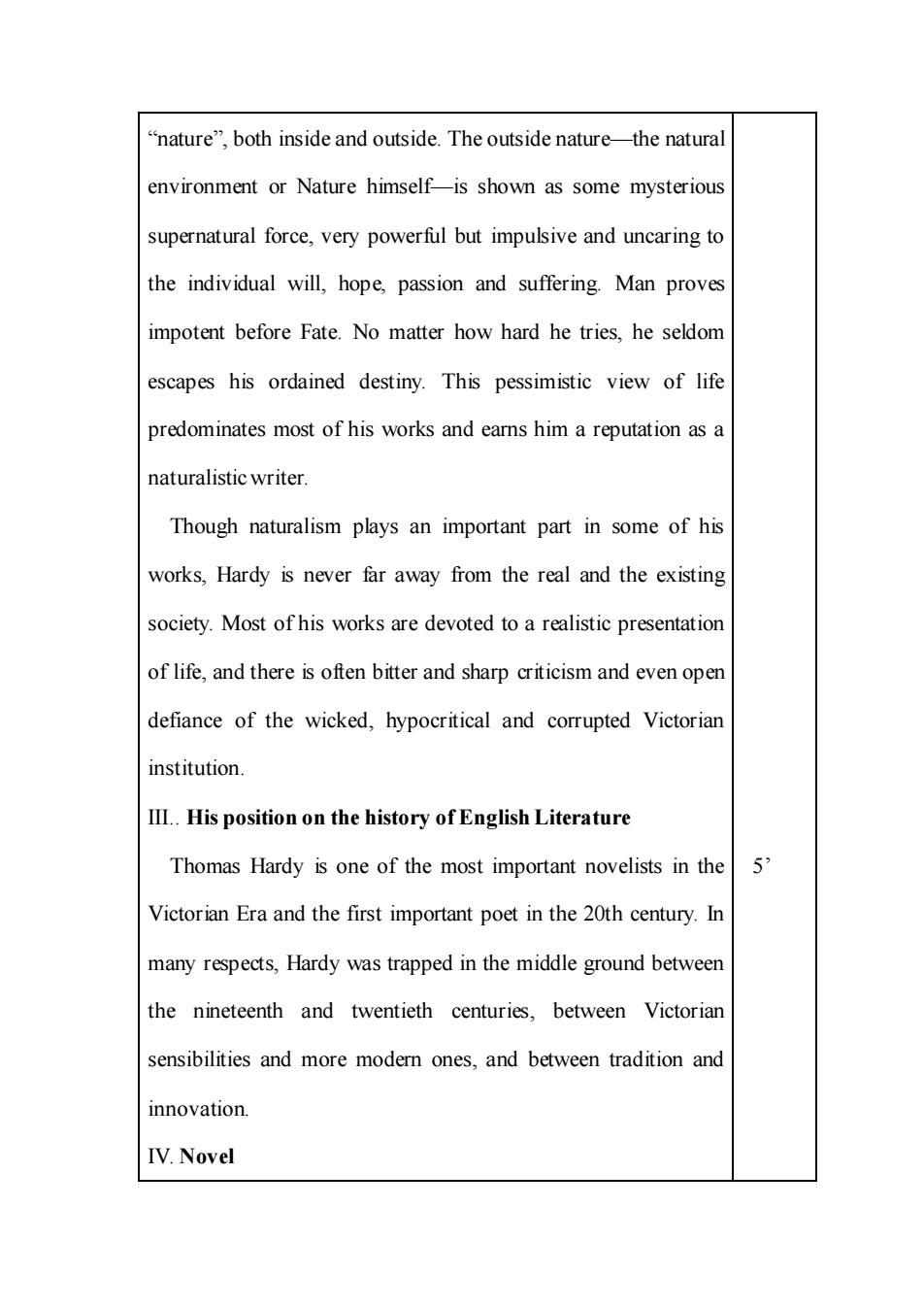
"nature",both inside and outside.The outside nature-the natural environment or Nature himselfis shown as some mysterious supernatural force,very powerful but impulsive and uncaring to the individual will,hope,passion and suffering.Man proves impotent before Fate.No matter how hard he tries,he seldom escapes his ordained destiny.This pessimistic view of life predominates most of his works and earns him a reputation as a naturalistic writer. Though naturalism plays an important part in some of his works,Hardy is never far away from the real and the existing society.Most of his works are devoted to a realistic presentation of life,and there is often bitter and sharp criticism and even open defiance of the wicked,hypocritical and corrupted Victorian institution. III.His position on the history of English Literature Thomas Hardy is one of the most important novelists in the 5 Victorian Era and the first important poet in the 20th century.In many respects,Hardy was trapped in the middle ground between the nineteenth and twentieth centuries,between Victorian sensibilities and more modern ones,and between tradition and innovation. IV.Novel
“nature”, both inside and outside. The outside nature—the natural environment or Nature himself—is shown as some mysterious supernatural force, very powerful but impulsive and uncaring to the individual will, hope, passion and suffering. Man proves impotent before Fate. No matter how hard he tries, he seldom escapes his ordained destiny. This pessimistic view of life predominates most of his works and earns him a reputation as a naturalistic writer. Though naturalism plays an important part in some of his works, Hardy is never far away from the real and the existing society. Most of his works are devoted to a realistic presentation of life, and there is often bitter and sharp criticism and even open defiance of the wicked, hypocritical and corrupted Victorian institution. III. His position on the history of English Literature Thomas Hardy is one of the most important novelists in the Victorian Era and the first important poet in the 20th century. In many respects, Hardy was trapped in the middle ground between the nineteenth and twentieth centuries, between Victorian sensibilities and more modern ones, and between tradition and innovation. IV. Novel 5’
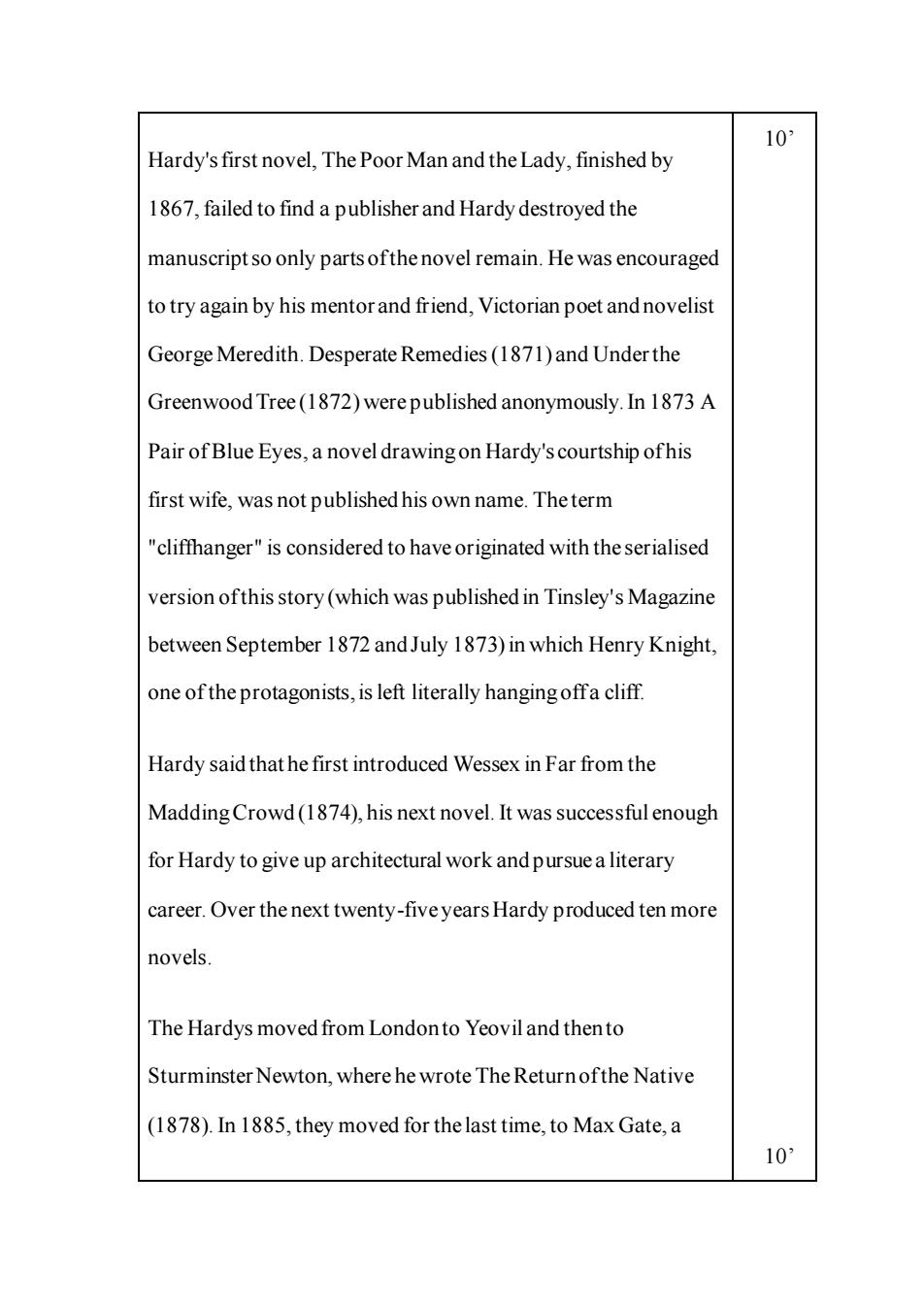
o. Hardy's first novel,The Poor Man and the Lady,finished by 1867,failed to find a publisher and Hardy destroyed the manuscript so only parts ofthe novel remain.He was encouraged to try again by his mentor and friend,Victorian poet andnovelist George Meredith.Desperate Remedies(1871)and Under the Greenwood Tree(1872)werepublished anonymously.In 1873 A Pair of Blue Eyes,a novel drawingon Hardy's courtship ofhis first wife,was not published his own name.The term "cliffhanger"is considered to haveoriginated with the serialised version ofthis story(which was published in Tinsley's Magazine between September 1872 and July 1873)in which Henry Knight. one ofthe protagonists,is left literally hangingoffa cliff. Hardy said that he first introduced Wessex in Far from the Madding Crowd(1874),his next novel.It was successful enough for Hardy to give up architectural work andpursue a literary career.Over the next twenty-five years Hardy produced ten more novels. The Hardys moved from Londonto Yeovil and thento Sturminster Newton,where he wrote The Returnofthe Native (1878).In 1885,they moved for the last time,to Max Gate,a 10
Hardy's first novel, The Poor Man and the Lady, finished by 1867, failed to find a publisher and Hardy destroyed the manuscript so only parts of the novel remain. He was encouraged to try again by his mentor and friend, Victorian poet and novelist George Meredith. Desperate Remedies (1871) and Under the Greenwood Tree (1872) were published anonymously. In 1873 A Pair of Blue Eyes, a novel drawing on Hardy's courtship of his first wife, was not published his own name. The term "cliffhanger" is considered to have originated with the serialised version of this story (which was published in Tinsley's Magazine between September 1872 and July 1873) in which Henry Knight, one of the protagonists, is left literally hanging off a cliff. Hardy said that he first introduced Wessex in Far from the Madding Crowd (1874), his next novel. It was successful enough for Hardy to give up architectural work and pursue a literary career. Over the next twenty-five years Hardy produced ten more novels. The Hardys moved from London to Yeovil and then to Sturminster Newton, where he wrote The Return of the Native (1878). In 1885, they moved for the last time, to Max Gate, a 10’ 10’

house outside Dorchester designed by Hardy and built by his brother.There he wrote The Mayor ofCasterbridge(1886),The Woodlanders(1887),and Tess ofthe d'Urbervilles(1891),the last of which attracted criticism for its sympathetic portrayal ofa "fallen woman"and was initially refused publication.Its subtitle, A Pure Woman:Faithfully Presented,was intended to raise the eyebrows ofthe Victorianmiddle-classes Jude the Obscure,published in 1895,met with even stronger negativeoutcries from the Victorian public for its frank treatment ofsex,and was often referred to as"Jude the Obscene".Heavily criticised for its apparent attack on the institution ofmarriage through the presentation ofsuch concepts as erotolepsy,the book caused further strainon Hardy'salready difficult marriage because Emma Hardy was concerned that Jude the Obscure would be read as autobiographical.Some booksellers sold the novel in brown paper bags,and the Bishop of Wakefield is reputed tohaveburnthis copy.[7]Inhispostscript of1912.Hardy humorously referred to this incident as part ofthe career of the book:"After these [hostile]verdicts from the press its next misfortune was to be burnt by a bishop-probably in his despair at not being able to burn me".[8]
house outside Dorchester designed by Hardy and built by his brother. There he wrote The Mayor of Casterbridge (1886), The Woodlanders(1887), and Tess of the d'Urbervilles (1891), the last of which attracted criticism for its sympathetic portrayal of a "fallen woman" and was initially refused publication. Its subtitle, A Pure Woman: Faithfully Presented, was intended to raise the eyebrows of the Victorian middle-classes. Jude the Obscure, published in 1895, met with even stronger negative outcries from the Victorian public for its frank treatment of sex, and was often referred to as "Jude the Obscene". Heavily criticised for its apparent attack on the institution of marriage through the presentation of such concepts as erotolepsy, the book caused further strain on Hardy's already difficult marriage because Emma Hardy was concerned that Jude the Obscure would be read as autobiographical. Some booksellers sold the novel in brown paper bags, and the Bishop of Wakefield is reputed to have burnt his copy.[7]In his postscript of 1912, Hardy humorously referred to this incident as part of the career of the book: "After these [hostile] verdicts from the press its next misfortune was to be burnt by a bishop – probably in his despair at not being able to burn me".[8]
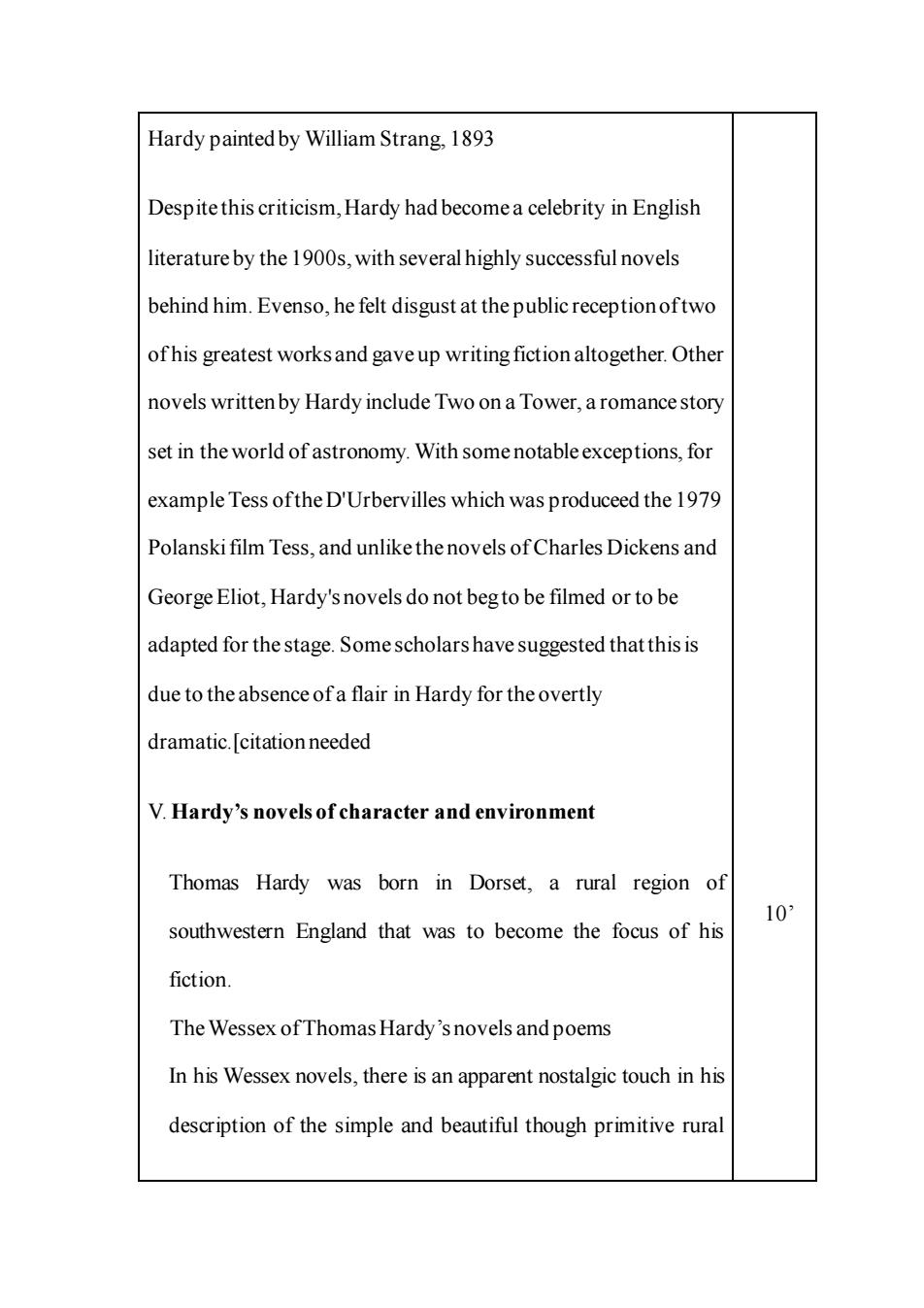
Hardy painted by William Strang.1893 Despite this criticism,Hardy had becomea celebrity in English literature by the 1900s,with several highly successful novels behind him.Evenso,he felt disgust at the public receptionoftwo of his greatest works and gave up writing fiction altogether.Other novels written by Hardy include Two on a Tower,a romance story set in the world of astronomy.With some notable exceptions,for example Tess ofthe D'Urbervilles which was produceed the 1979 Polanskifilm Tess,and unlikethe novels of Charles Dickens and George Eliot,Hardy's novels do not begto be filmed or to be adapted for the stage.Some scholars have suggested that this is due to theabsence ofa flair in Hardy for theovertly dramatic.[citation needed V.Hardy's novels of character and environment Thomas Hardy was born in Dorset,a rural region of 10 southwestern England that was to become the focus of his fiction. The Wessex of Thomas Hardy's novels and poems In his Wessex novels,there is an apparent nostalgic touch in his description of the simple and beautiful though primitive rural
Hardy painted by William Strang, 1893 Despite this criticism, Hardy had become a celebrity in English literature by the 1900s, with several highly successful novels behind him. Evenso, he felt disgust at the public reception of two of his greatest works and gave up writing fiction altogether. Other novels written by Hardy include Two on a Tower, a romance story set in the world of astronomy. With some notable exceptions, for example Tess of the D'Urbervilles which was produceed the 1979 Polanski film Tess, and unlike the novels of Charles Dickens and George Eliot, Hardy's novels do not beg to be filmed or to be adapted for the stage. Some scholars have suggested that this is due to the absence of a flair in Hardy for the overtly dramatic.[citation needed V. Hardy’s novels of character and environment Thomas Hardy was born in Dorset, a rural region of southwestern England that was to become the focus of his fiction. The Wessex of Thomas Hardy’s novels and poems In his Wessex novels, there is an apparent nostalgic touch in his description of the simple and beautiful though primitive rural 10’

life,which was gradually declining and disappearing as England was marching fast into an industrial country.And with those traditional characters he is always sympathetic and mournsover their failure and misfortune Far from the Madding Crowd,1874 The Return ofthe Native,1878 The Mayor ofCasterbridge,1886 Tess ofthe d'Urbervilles,1891 Jude the Obscure,1896 VI.Literary themes Hardy criticises certain social constraints that hindered the 10 lives ofthose living in the 19th century.Considered a Victorian Realist writer,Hardy examines the social constraints that are part of the Victorian status quo,suggesting these rules hinder the lives of all involved and ultimately lead to unhappiness.In Two on a Tower,Hardy seeks to take a stand against these rules and sets up a story against the backdrop of social structure by creating a story of love that crosses the boundaries ofclass.The reader is forced to consider disposing of the conventions set up for love.Nineteenth-century society enforces these conventions,and societal pressure ensures conformity.Swithin St Cleeve's idealism pits him against contemporary social
life, which was gradually declining and disappearing as England was marching fast into an industrial country. And with those traditional characters he is always sympathetic and mourns over their failure and misfortune. Far from the Madding Crowd, 1874 The Return of the Native, 1878 The Mayor of Casterbridge, 1886 Tess of the d'Urbervilles, 1891 Jude the Obscure, 1896 VI. Literary themes Hardy criticises certain social constraints that hindered the lives of those living in the 19th century. Considered a Victorian Realist writer, Hardy examines the social constraints that are part of the Victorian status quo, suggesting these rules hinder the lives of all involved and ultimately lead to unhappiness. In Two on a Tower, Hardy seeks to take a stand against these rules and sets up a story against the backdrop of social structure by creating a story of love that crosses the boundaries of class. The reader is forced to consider disposing of the conventions set up for love. Nineteenth-century society enforces these conventions, and societal pressure ensures conformity. Swithin St Cleeve's idealism pits him against contemporary social 10’
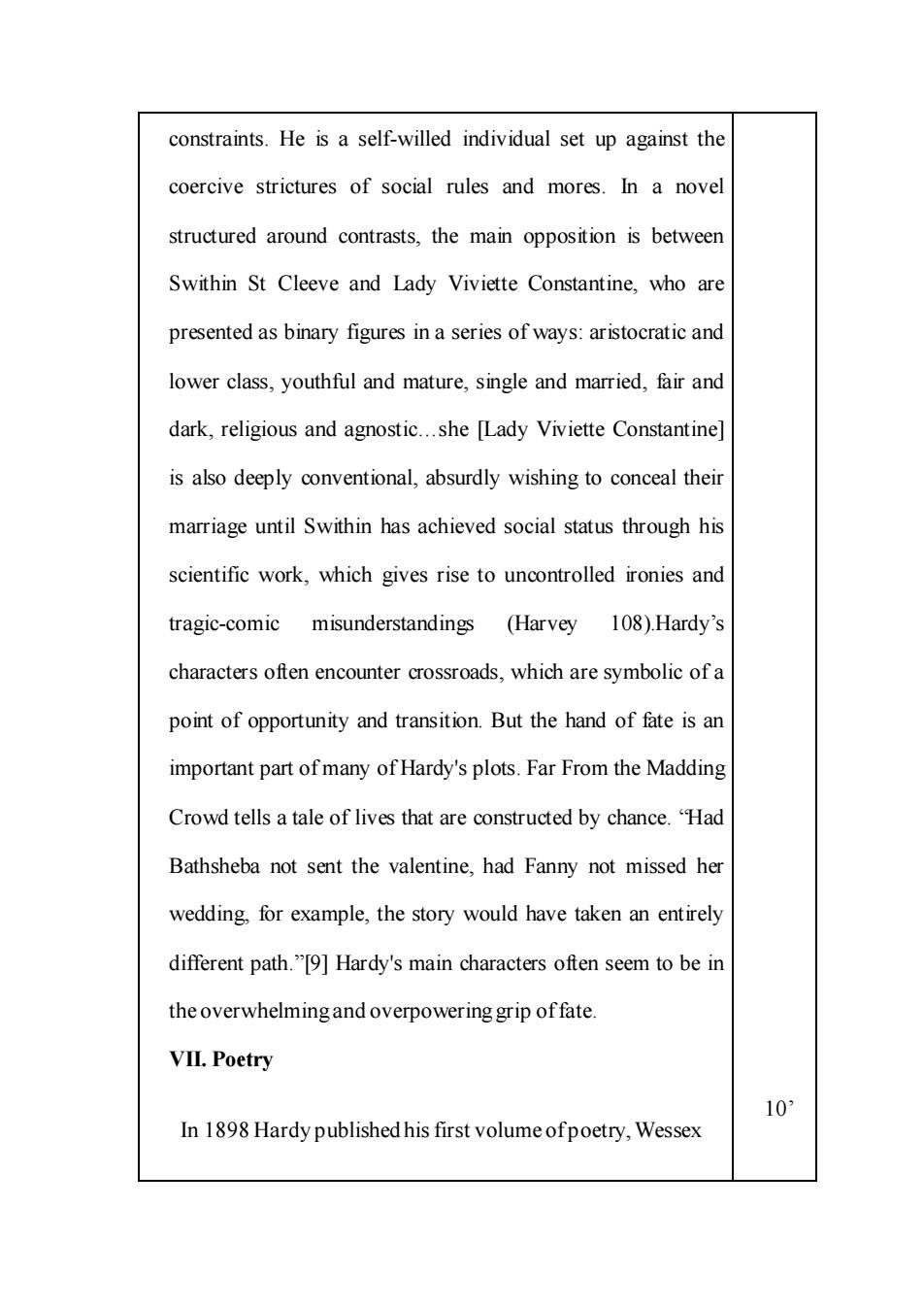
constraints.He is a self-willed individual set up against the coercive strictures of social rules and mores.In a novel structured around contrasts,the main opposition is between Swithin St Cleeve and Lady Viviette Constantine,who are presented as binary figures in a series of ways:aristocratic and lower class,youthful and mature,single and married,fair and dark,religious and agnostic.she [Lady Viviette Constantine] is also deeply conventional,absurdly wishing to conceal their marriage until Swithin has achieved social status through his scientific work,which gives rise to uncontrolled ironies and tragic-comic misunderstandings (Harvey 108).Hardy's characters often encounter crossroads,which are symbolic of a point of opportunity and transition.But the hand of fate is an important part of many of Hardy's plots.Far From the Madding Crowd tells a tale of lives that are constructed by chance."Had Bathsheba not sent the valentine,had Fanny not missed her wedding,for example,the story would have taken an entirely different path."[9]Hardy's main characters often seem to be in the overwhelming and overpowering grip of fate. VII.Poetry 10 In 1898 Hardy published his first volume ofpoetry,Wessex
constraints. He is a self-willed individual set up against the coercive strictures of social rules and mores. In a novel structured around contrasts, the main opposition is between Swithin St Cleeve and Lady Viviette Constantine, who are presented as binary figures in a series of ways: aristocratic and lower class, youthful and mature, single and married, fair and dark, religious and agnostic.she [Lady Viviette Constantine] is also deeply conventional, absurdly wishing to conceal their marriage until Swithin has achieved social status through his scientific work, which gives rise to uncontrolled ironies and tragic-comic misunderstandings (Harvey 108).Hardy’s characters often encounter crossroads, which are symbolic of a point of opportunity and transition. But the hand of fate is an important part of many of Hardy's plots. Far From the Madding Crowd tells a tale of lives that are constructed by chance. “Had Bathsheba not sent the valentine, had Fanny not missed her wedding, for example, the story would have taken an entirely different path.”[9] Hardy's main characters often seem to be in the overwhelming and overpowering grip of fate. VII. Poetry In 1898 Hardy published his first volume of poetry, Wessex 10’